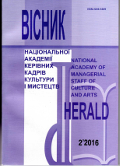THE BOOK OF THE DEAD ON THE STELAE OF THE NEW KINGDOM
DOI:
https://doi.org/10.32461/2226-3209.2.2016.138507Keywords:
stelae, the Book of the Dead, the New Kingdom, vignettes, Ancient EgyptAbstract
The purpose of the research. This research is devoted to the significant phenomenon of locating individual parts of the ancient Egyptian Book of the Dead on the unusual type of sources. Attention is focused on the previously unexplored phenomenon of the Book’s of the Dead text and/or illustrations placement on the funerary stelae – commemorative plates, installed in the tombs and funerary temples of individuals. The place of this type of the sources in the context of the entire volume of the Book of the Dead is considered. The chronological framework of the existence of stelae with text/images from the Book of the Dead is described: all currently known stelae are exemplified. The integration of the main plot into the system of funerary stelae is described. The research methodology applied to this study is the use of the comparative method. Without a comprehensive analysis of the exact sources it made possible the consideration of the phenomenon as a whole. Scientific novelty of the article consists of studying of the fact of placing text and/or illustrations from the Book of the Dead on the funerary stelae. This research helped to trace the way of integration of the Book’s of the Dead motives into the funeral cult system of the stelae owners. Conclusions. This research helped to identify the most popular scene from the Book of the Dead, which was integrated into the funeral stelae system during the New Kingdom. It was determined that the motive of the scene corresponds well to the funeral stelae role and thus, substantiates the usage of this sort of sources for the placement of the Book’s of the Dead vignettes.
Downloads
Published
Issue
Section
License
Authors who publish with this journal agree to the following terms:
1. Authors retain copyright and grant the journal right of first publication with the work simultaneously licensed under a Creative Commons Attribution License International CC-BY that allows others to share the work with an acknowledgement of the work's authorship and initial publication in this journal.
2. Authors are able to enter into separate, additional contractual arrangements for the non-exclusive distribution of the journal's published version of the work (e.g., post it to an institutional repository or publish it in a book), with an acknowledgement of its initial publication in this journal.
3. Authors are permitted and encouraged to post their work online (e.g., in institutional repositories or on their website) prior to and during the submission process, as it can lead to productive exchanges, as well as earlier and greater citation of published work (See The Effect of Open Access).


